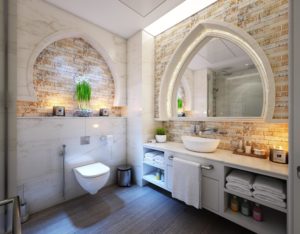Positioned on the southern coast of Lake Michigan in one of the coldest regions of the U.S., Chicago provides nearly year-round perfect climates for mold and mildew growth in your home. Certain areas of your home, such as the kitchen, bathroom, basement and even your carpets are highly susceptible to moisture and, in turn, mold and mildew may grow – which could affect the quality of air.
During the warmer months, Chicago’s residents know how much humidity and moisture is brought in by the lake itself and the summer showers that come with seasonal changes. This humidity can seep into your home and create moisture in unexpected areas. In the winter, many Chicago homeowners and renters are faced with the possibility of frozen, broken pipes or even basement flooding from fallen snow once the temperature allows for melting – leading the water straight into your home. (Scary!)
As we’ve discussed before, most mold issues can be easily remediated. However, prevention should be of utmost importance – especially before seasonal changes – as oftentimes, the problem is not identified until it’s too late.
Learn more about mold and mold remediation here and discover how easy it can be to prevent mold growth in your home below.
Preventing Kitchen Mold

Your kitchen is probably the epicenter of your home, and you may be surprised to find that it’s got the perfect nooks and crannies for moisture to turn to mold due to the level of activity, cooking and the general size of appliances that many may never think to move. Once a mold problem sets in your kitchen, it’s a little harder to completely eliminate. Here’s what you can do to prevent it.
- Mold Resistant Paint: Using mold resistant paint in your kitchen will provide an extra layer of protection from mold and mildew, and can be found at most home improvement stores.
- Keep it Dry: This might sound like a no brainer, but it’s important to keep in mind. Run your faucet on low while washing dishes or rinsing produce to avoid splashing water on the counter or around the sink. Make sure to clean and dry spills right away (even water) before it can penetrate the surface of your counter.
- Avoid Carpets & Rugs: Who doesn’t love a soft surface underfoot while being bustling about the house? Carpets are great for that, but there’s no place for them in the kitchen! Because carpets tend to absorb and trap moisture, these warm surfaces offer the idea breeding grounds for mold and mildew to grow. Though rugs can be washed, it’s often difficult to keep track of what’s going on under there – it’s best to keep them out of your kitchen all together.
- Clean Your Cabinets: Regularly inspect and clean/dry the walls in your cabinets where mold and mildew may grow unnoticed.
- Take a Look Behind Your Cooking Range: As we’ve said, a lot of moisture is created while cooking and it may be trapped behind and under your stove if there is insufficient or inadequate ventilation. Make it a habit to move your range every few weeks to thoroughly clean and dry the floor and the walls that house it.
- Fix Leaks & Broken Pipes: This could easily be #1 on this list. Leaks in kitchens can originate from a number of places including your sink, under your sink, broken plumbing, the fridge and even your dishwasher. Always be on the lookout for dampness, moisture or dripping water. If found, fix immediately and ensure that the area is completely dry.
- Keep Your Fridge Tidy: Keeping your refrigerator clean and well maintained reduces the chances of the appliance breaking down and leaking water which promotes the growth of mildew. Clean the inside as well as moving the fridge in order to thoroughly clean its sides and the walls which surround it.
- Open Windows & Run Exhaust: Opening windows or running the exhaust fan in your kitchen can provide proper ventilation and airflow can prevent mold formation greatly. Given that we’re in Chicago, keeping the windows open isn’t always an option – run your exhaust!
Note: If you’ve already found mold in your kitchen, refer to our mold guidelines and give us a call for your free estimate.
Preventing Bathroom Mold

Much like the kitchen, the bathroom is another typically humid, moist (and busy) area of your home and is therefore a great place for mold and mildew to find a cozy corner to grow. The key to your bathroom prevention is eliminating dampness as much as you can. There are a few simple ways to do that!
- Squeegee: Use a squeegee to wipe down bath/shower walls to help eliminate nearly ¾ of the moisture that could lead to mildew.
- Run the Fan: Most bathrooms come equipped with fans to help keep the air in there dry. Be sure to run the fans during your bath/shower and for 30 minutes afterwards to help flush out the dampness.
- Seal the Grout: Have tile in your bathroom? Seal the grout lines annually with standard grout sealer which can be found at most home improvement stores.
*Currently have bathroom mold? Scrub with detergent and water, then let dry completely. You may also use a solution of 10% bleach and 90% water (any stronger won’t help). Spray or brush on the solution, let sit for 10 minutes, rinse off and let dry completely.
If you have any questions, concerns or are already experiencing mold issues in your home – we’re here for you. Get in touch with one of our experts today for your free estimate.
